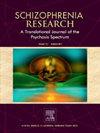社会资源对急性精神分裂症患者再入院预防的影响及非正式胁迫的影响:一项回顾性准实验队列研究
IF 3.5
2区 医学
Q1 PSYCHIATRY
引用次数: 0
摘要
在住院期间,在有或没有非正式胁迫的情况下,引入社会资源,作为支持社区急性精神分裂症患者生活的手段。然而,无论是一般的社会资源对防止再入院的影响,还是非正式胁迫对临床结果的影响,都尚不清楚。我们的目的是研究社会资源对预防急性精神分裂症患者再入院的总体效果和非正式胁迫的临床影响。方法本研究确定了659名精神分裂症患者,对他们进行了两年的随访,并使用治疗加权反概率Kaplan-Meier和Cox比例风险分析进行了生存分析。参与者首先按社会资源介绍分组。拒绝介绍的人进一步分为强制介绍、引诱介绍和个人需要组。结果社会资源引入组患者再入院风险显著低于对照组(风险比[HR]: 0.75; 95%可信区间[CI]: 0.57 ~ 0.99; P = 0.041)。需要治疗的人数为7.2人。强制引荐组无再入院风险降低(HR: 1.53; 95% CI: 0.75 ~ 3.13; P = 0.24),而强制引荐组的再入院风险显著低于个人需求组(HR: 0.50; 95% CI: 0.31 ~ 0.82; P = 0.006)。结论引入社会资源可以预防急性精神分裂症患者再入院,但强制引入可能会抵消这种效果。医务人员在引入社会资源时应避免非正式胁迫,采取激发动机的策略。本文章由计算机程序翻译,如有差异,请以英文原文为准。

Effect of social resources on readmission prevention and the influence of informal coercion in acute schizophrenia: a retrospective quasi-experimental cohort study
Introduction
During hospitalization, social resources are introduced with or without informal coercion as means of supporting the life of people with acute schizophrenia in the community. However, neither the effect of social resources in general on preventing readmission nor that of informal coercion on clinical outcomes is known. We aimed to examine the overall effect of social resources on preventing the readmission of people with acute schizophrenia and the clinical impact of informal coercion.
Methods
The present study identified 659 participants with schizophrenia, followed them for two years, and performed survival analyses using inverse probability of treatment weighting Kaplan-Meier and Cox proportional hazards analyses. Participants were first grouped by the social resource introduction. Those who declined the introduction were further categorized into coercive introduction, elicitory introduction, or personal needs groups.
Results
Participants in the social resource introduction group had a significantly lower risk of readmission than those in the control group (hazard ratio [HR]: 0.75; 95 % confidence interval [CI]: 0.57–0.99; P = 0.041). The number needed to treat was 7.2. The coercive introduction group showed no readmission risk reduction (HR: 1.53; 95 % CI: 0.75–3.13; P = 0.24) while the elicitory introduction group had a significantly lower risk than the personal needs group (HR: 0.50; 95 % CI: 0.31–0.82; P = 0.006).
Conclusions
Introducing social resources can prevent readmission for acute schizophrenia, but coercive introduction may negate this benefit. Medical staff should avoid informal coercion and adopt strategies that elicit motivation when introducing social resources.
求助全文
通过发布文献求助,成功后即可免费获取论文全文。
去求助
来源期刊

Schizophrenia Research
医学-精神病学
CiteScore
7.50
自引率
8.90%
发文量
429
审稿时长
10.2 weeks
期刊介绍:
As official journal of the Schizophrenia International Research Society (SIRS) Schizophrenia Research is THE journal of choice for international researchers and clinicians to share their work with the global schizophrenia research community. More than 6000 institutes have online or print (or both) access to this journal - the largest specialist journal in the field, with the largest readership!
Schizophrenia Research''s time to first decision is as fast as 6 weeks and its publishing speed is as fast as 4 weeks until online publication (corrected proof/Article in Press) after acceptance and 14 weeks from acceptance until publication in a printed issue.
The journal publishes novel papers that really contribute to understanding the biology and treatment of schizophrenic disorders; Schizophrenia Research brings together biological, clinical and psychological research in order to stimulate the synthesis of findings from all disciplines involved in improving patient outcomes in schizophrenia.
 求助内容:
求助内容: 应助结果提醒方式:
应助结果提醒方式:


